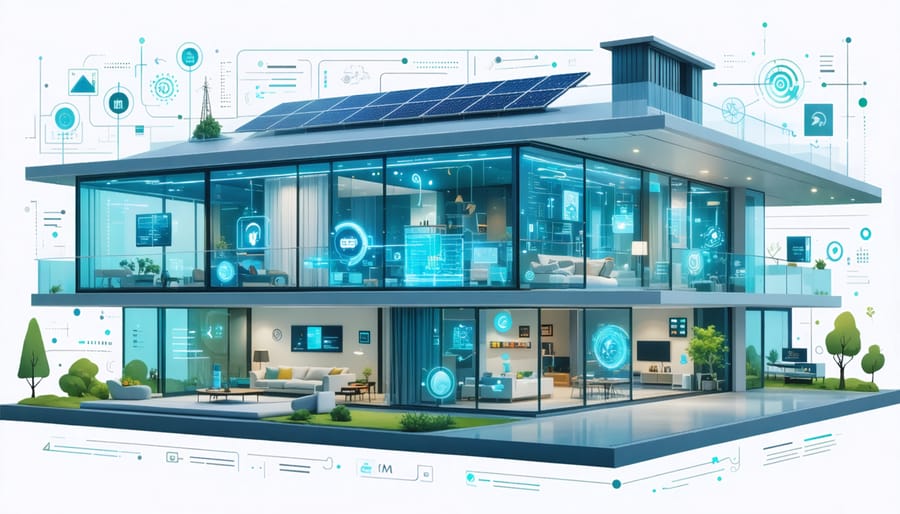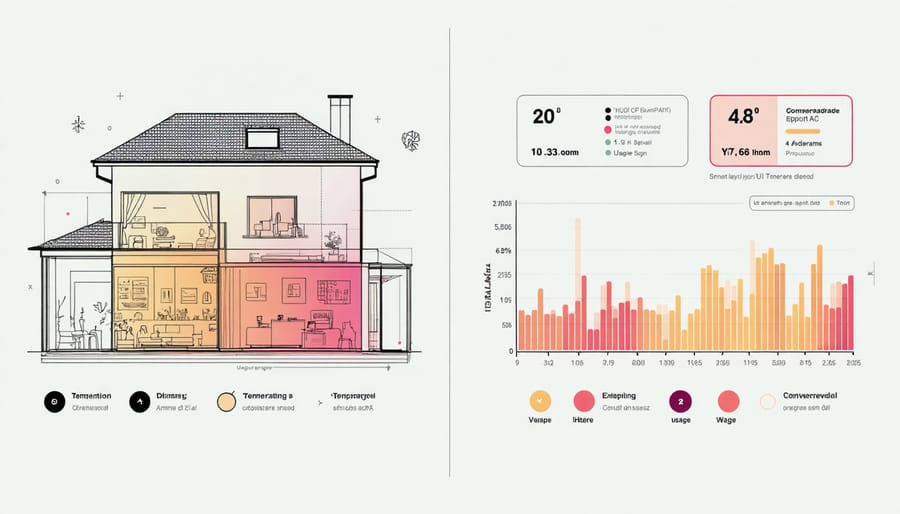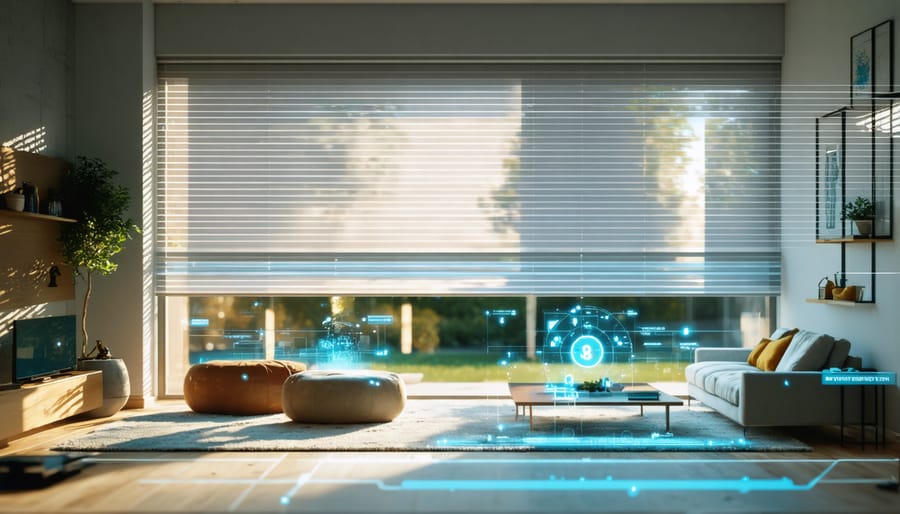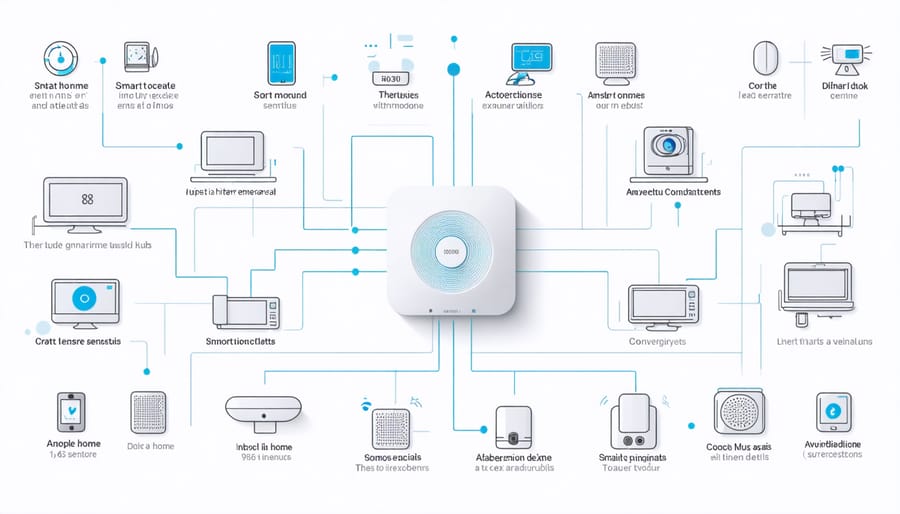
Smart Homes That Fight Climate Change: How Adaptive AI Makes Your Space More Sustainable
Adaptive AI represents a groundbreaking evolution in artificial intelligence, learning and adjusting its behavior in real-time based on new data and changing environments. Unlike traditional AI systems that follow fixed rules, adaptive AI continuously refines its decision-making processes through dynamic feedback loops, much like a smart thermostat that learns your temperature preferences over time. This technology is revolutionizing home automation, from smart lighting systems that anticipate your daily routines to HVAC controls that optimize energy usage based on occupancy patterns and weather conditions.
Think of adaptive AI as your home’s always-learning personal assistant – it starts with basic programming but grows more intelligent and personalized with every interaction. Whether you’re a homeowner looking to reduce energy costs or a property manager seeking automated solutions, adaptive AI systems offer a practical path to smarter, more efficient living spaces. The beauty lies in their ability to adapt without constant human intervention, making your home genuinely responsive to your lifestyle while maximizing comfort and efficiency.
How Adaptive AI Transforms Your Home’s Climate Response
Learning Your Comfort Patterns
Modern adaptive AI systems act like attentive housekeepers, quietly observing and learning your daily routines and preferences. These smart systems track when you typically wake up, leave for work, return home, and go to bed. They notice your preferred temperature settings throughout the day and how these preferences change with the seasons.
For example, if you consistently lower the temperature to 68°F before bedtime, the system learns this pattern and begins adjusting automatically. It also picks up on subtle preferences, like how you might prefer a warmer living room in the morning but cooler temperatures while cooking dinner.
What makes these systems truly remarkable is their ability to adapt to changes in your routine. If you start working from home more often or have guests staying over, the AI recognizes these temporary shifts and adjusts accordingly. The system even learns from your manual overrides, using this feedback to fine-tune its understanding of your comfort preferences.
Over time, this continuous learning creates a personalized comfort profile that anticipates your needs before you even think about adjusting the thermostat.

Real-Time Environmental Adjustments
Modern smart climate control systems are becoming increasingly sophisticated in their ability to read and respond to real-time environmental conditions. These systems continuously monitor various factors like outdoor temperature, humidity levels, and sunlight intensity to make automatic adjustments that maintain optimal indoor comfort.
What’s particularly impressive is how these systems learn from occupancy patterns in your home. They track when rooms are typically used and adjust temperatures accordingly. For example, if your home office is usually empty after 6 PM, the system will automatically reduce heating or cooling in that space while maintaining comfort in areas where family members gather in the evening.
Weather changes are another key factor these systems handle beautifully. When a sudden temperature drop is detected outside, the system preemptively adjusts indoor settings to maintain consistency. It can even factor in weather forecasts to prepare for upcoming temperature swings, ensuring your home stays comfortable while using energy efficiently.
The system also considers factors like window placement, insulation quality, and heat from appliances when making its calculations, creating a truly personalized comfort experience for your home.
Smart Features That Make Your Home Climate-Ready

Automated Shading and Natural Light Control
Imagine your home automatically adjusting its window treatments throughout the day, maximizing natural light while maintaining optimal temperature and energy efficiency. This is exactly what adaptive AI brings to modern automated lighting solutions, creating a perfect balance between comfort and sustainability.
The system uses sensors to monitor external light levels, time of day, and indoor conditions. During summer mornings, it might partially close blinds on east-facing windows to prevent heat build-up while still allowing natural light to illuminate your space. In winter, it could maximize sun exposure during peak hours to help warm your home naturally.
What makes this AI truly adaptive is its ability to learn from your preferences and daily patterns. If you frequently adjust the blinds manually at certain times, the system notes these preferences and incorporates them into its automation routines. It also considers factors like glare on TV screens or workstations, automatically adjusting shading to prevent discomfort.
The real magic happens when this system integrates with your home’s other smart features. It works in harmony with your HVAC system and artificial lighting, creating a comprehensive approach to both comfort and energy management. For example, by optimizing natural light usage, it reduces the need for artificial lighting during daylight hours, leading to significant energy savings over time.
Intelligent HVAC Management
Modern smart HVAC management systems represent one of the most practical applications of adaptive AI in our daily lives. These intelligent systems go far beyond simple programmable thermostats by actively learning from your household’s patterns and preferences.
Think of it as having a smart assistant that understands exactly when you need heating or cooling. The system monitors various factors like occupancy patterns, outdoor weather conditions, and even individual room usage to make real-time adjustments. For example, if you typically work from home in your office from 9 AM to 5 PM, the system will prioritize comfort in that space during those hours while reducing energy usage in unused areas.
What makes these systems truly adaptive is their ability to learn and improve over time. They analyze historical data about your temperature preferences, energy consumption patterns, and even local weather forecasts to optimize your home’s climate control. This learning process helps reduce energy waste while maintaining optimal comfort levels.
The real magic happens in the background as the AI constantly fine-tunes its operations. When you adjust the temperature manually, the system notes these preferences and incorporates them into its decision-making process. This continuous adaptation means your HVAC system becomes more efficient and personalized with each passing day, leading to significant energy savings and improved comfort levels throughout your home.
Setting Up Your Climate-Adaptive Home
Essential Components and Installation Tips
Setting up adaptive AI in your home requires a few key components to work effectively. At the heart of the system, you’ll need a central processing unit or smart hub that serves as the brain of your setup. This connects to various sensors throughout your space, which collect real-time data about temperature, humidity, occupancy, and energy usage.
The basic hardware package typically includes:
– A smart thermostat with WiFi connectivity
– Multiple room sensors
– A compatible smart home hub
– Environmental sensors for temperature and humidity
– Motion detectors for occupancy tracking
When installing these components, placement is crucial. Temperature sensors work best when mounted away from direct sunlight and heat sources, typically at chest height on interior walls. Motion sensors should be positioned in high-traffic areas without obstruction, while the main hub needs a central location with strong WiFi coverage.
For optimal performance, ensure your home’s WiFi network is reliable and covers all areas where sensors are installed. Many homeowners find it helpful to upgrade their router or add WiFi extenders before completing the installation. You’ll also want to consider backup power options for critical components to maintain functionality during power outages.
Remember to check device compatibility before purchasing, as not all smart home systems work together seamlessly. Most manufacturers provide detailed compatibility charts on their websites.

Integration with Existing Home Systems
Integrating adaptive AI into your existing home systems is easier than you might think. Most modern smart home hubs, including popular platforms like Google Home, Amazon Alexa, and Apple HomeKit, are already equipped to work with adaptive AI technology. The key is ensuring your devices can communicate with each other through protocols like Wi-Fi, Zigbee, or Z-Wave.
Start by connecting your smart thermostat to your home automation hub. This serves as the central point for temperature control and learning. Next, add compatible sensors throughout your home to monitor factors like occupancy, humidity, and natural light levels. These sensors feed valuable data to your adaptive AI system, helping it make more informed decisions about your home’s climate control.
Many manufacturers now offer plug-and-play solutions that can integrate with your existing setup through simple smartphone apps. Look for devices labeled as “AI-compatible” or “machine learning enabled” when expanding your system. For older homes with traditional HVAC systems, smart controllers can bridge the gap between conventional equipment and adaptive AI capabilities.
Remember to regularly update your devices’ firmware to ensure optimal performance and compatibility. Most systems will automatically adjust their settings based on your daily routines within a few weeks of installation, but you can always fine-tune the preferences through your smartphone app or control panel.
Adaptive AI represents a game-changing advancement in how we manage our homes and properties, offering unprecedented levels of comfort, efficiency, and control. By learning from our daily routines and preferences, these intelligent systems continuously evolve to provide better, more personalized experiences while significantly reducing energy consumption and costs.
The benefits of implementing adaptive AI in your home extend far beyond basic automation. From optimizing your HVAC system based on your family’s schedule to adjusting lighting patterns that match your lifestyle, these smart solutions create a living space that truly understands and anticipates your needs. The energy savings alone can justify the initial investment, with many homeowners reporting substantial reductions in their utility bills within the first year.
As we move toward a more sustainable future, adaptive AI technology stands at the forefront of smart home innovation. Whether you’re a homeowner looking to enhance your living space, a property manager seeking efficient building solutions, or an environmentally conscious individual wanting to reduce your carbon footprint, now is the perfect time to embrace this technology.
Taking the first step toward implementing adaptive AI doesn’t have to be overwhelming. Start small with a single system, like smart thermostats or lighting controls, and gradually expand as you become more comfortable with the technology. The key is to begin the journey toward a smarter, more efficient home today.
Remember, the future of home automation is here, and it’s more accessible than ever. By embracing adaptive AI, you’re not just upgrading your home – you’re investing in a more comfortable, efficient, and sustainable future for you and your family.
